Different Tea Germplasms Distinctly Influence the Adaptability of Toxoptera aurantii (Hemiptera: Aphididae)
Abstract
Simple Summary
Abstract
1. Introduction
2. Materials and Methods
2.1. Test Materials
2.1.1. Insects
2.1.2. Tea Germplasm Materials
2.2. Test Methods
2.2.1. EPG Recording
2.2.2. Life Table Construction
2.3. Statistical Analysis
3. Results
3.1. Measuring T. aurantii Feeding Behavior by EPG
3.2. Probing Behavior of T. aurantii Stylets in Non-Phloem Phase
3.3. Probing Behavior of T. aurantii Stylets in Phloem Phase
3.4. Average Percentage of Time per Waveform during 6 h
3.5. Life Table Analysis
4. Discussion
Author Contributions
Funding
Institutional Review Board Statement
Informed Consent Statement
Data Availability Statement
Acknowledgments
Conflicts of Interest
References
- Fang, Y.; Jiao, X.G.; Xie, W.; Wang, S.L.; Wu, Q.J.; Shi, X.B.; Chen, G.; Su, Q.; Yang, X.; Pan, H.P.; et al. Tomato yellow leaf curl virus alters the host preferences of its vector Bemisia tabaci. Sci. Rep. 2013, 3, 2876. [Google Scholar] [CrossRef]
- Chesnais, Q.; Couty, A.; Uzest, M.; Brault, V.; Ameline, A. Plant infection by two different viruses induce contrasting changes of vectors fitness and behavior. Insect Sci. 2019, 26, 86–96. [Google Scholar] [CrossRef] [PubMed]
- Edwards, O.R. Interspecific and intraspecific variation in the performance of three pest aphid species on five grain legume hosts. Entomol. Exp. Appl. 2001, 100, 21–30. [Google Scholar] [CrossRef]
- Liu, X.D.; Zhai, B.P.; Zhang, X.X. Specialized host-plant performance of the cotton aphid is altered by experience. Ecol. Res. 2008, 23, 919–925. [Google Scholar] [CrossRef]
- Guo, J.Q.; Hao, G.; Hatt, S.; Wang, Z.Y.; Francis, F. Host plant adaptability and proteomic differences of diverse Rhopalosiphum maidis (fitch) lineages. Arch. Insect Biochem. Physiol. 2022, 109, e21853. [Google Scholar] [CrossRef]
- Ali, M.Y.; Naseem, T.; Arshad, M.; Ashraf, I.; Rizwan, M.; Tahir, M.; Rizwan, M.; Sayed, S.; Ullah, M.I.; Khan, R.R.; et al. Host-plant variations affect the biotic potential, survival, and population projection of Myzus persicae (Hemiptera: Aphididae). Insects 2021, 12, 375. [Google Scholar] [CrossRef]
- Tan, S.Y.; Hong, F.; Ye, C.; Wang, J.J.; Wei, D. Functional characterization of four hsp70 genes involved in high-temperature tolerance in Aphis aurantii (Hemiptera: Aphididae). Int. J. Biol. Macromol. 2022, 202, 141–149. [Google Scholar] [CrossRef]
- Li, L.K.; Wang, M.F.; Pokharel, S.S.; Li, C.X.; Parajulee, M.N.; Chen, F.J.; Fang, W.P. Effects of elevated CO2 on foliar soluble nutrients and functional components of tea, and population dynamics of tea aphid, Toxoptera aurantii. Plant Physiol. Biochem. 2019, 145, 84–94. [Google Scholar] [CrossRef]
- Pu, D.Q.; Mao, J.H.; Chen, Y.; Luo, X.; Liu, C. Occurrence and green control technology of tea aphid. Sichuan Agric. Sci. Technol. 2019, 5, 40–41. [Google Scholar]
- Tang, Y.Q.; Weathersbee, A.A.; Mayer, R.T. Effect of neem seed extract on the brown citrus aphid (Homoptera: Aphididae) and its parasitoid Lysiphlebus testaceipes (Hymenoptera: Aphidiidae). Environ. Entomol. 2002, 31, 172–176. [Google Scholar] [CrossRef]
- Smaili, M.C.; Ghadraoui, L.E.; Gaboun, F.; Benkirane, R.; Blenzar, A. Impact of some alternative methods to chemical control in Controlling aphids (Hemiptera: Sternorrhyncha) and their side effects on natural enemies on young Moroccan citrus groves. Phytoparasitica 2014, 42, 421–436. [Google Scholar] [CrossRef]
- Zheng, X.M.; Tao, Y.L.; Chi, H.; Wan, F.H.; Chu, D. Adaptability of small brown planthopper to four rice cultivars using life table and population projection method. Sci. Rep. 2017, 7, 42399. [Google Scholar] [CrossRef] [PubMed]
- Zhao, R.N.; Wu, C.X.; He, Y.Q.; Yu, C.; Liu, J.F.; Li, T.S.; Zhou, C.Y.; Chen, W.L. Different host plants distinctly influence the feeding ability of the brown citrus aphid Toxoptera citricida. Insects 2021, 12, 864. [Google Scholar] [CrossRef]
- Saxena, K.N.; Gandhi, J.R.; Saxena, R.C. Patterns of relationship between certain leafhoppers and plants. I. Responses to plants. Entomol. Exp. Appl. 1974, 17, 303–318. [Google Scholar] [CrossRef]
- Kimmins, F.M.; Tjallingii, W.F. Ultrastructure of sieve element penetration by aphid stylets during electrical recording. Entomol. Exp. Appl. 1985, 39, 135–141. [Google Scholar] [CrossRef]
- Tjallingii, W.F.; Esch, T.H.H. Fine structure of aphid stylet routes in plant tissues in correlation with epg signals. Physiol. Entomol. 1993, 18, 317–328. [Google Scholar] [CrossRef]
- Jiménez, J.; Garzo, E.; Alba-Tercedor, J.; Moreno, A.; Fereres, A.; Walker, G.P. The phloem-pd: A distinctive brief sieve element stylet puncture prior to sieve element phase of aphid feeding behavior. Arthropod-Plant Interact. 2020, 14, 67–78. [Google Scholar] [CrossRef]
- Lu, H.; Yang, P.C.; Xu, Y.Y.; Luo, L.; Zhu, J.J.; Cui, N.; Kang, L.; Cui, F. Performances of survival, feeding behavior, and gene expression in aphids reveal their different fitness to host alteration. Sci. Rep. 2016, 6, 19344. [Google Scholar] [CrossRef] [PubMed]
- Nam, K.J.; Hardie, J. Host acceptance by aphids: Probing and larviposition behaviour of the bird cherry-oat aphid, Rhopalosiphum padi on host and non-host plants. J. Insect Physiol. 2012, 58, 660–668. [Google Scholar] [CrossRef]
- Jiang, W.B.; Cheng, Q.; Lu, C.H.; Chen, W.L.; Zhao, D.G.; He, Y.Q. Different host plants distinctly influence the adaptability of Myzus persicae (Hemiptera: Aphididae). Agriculture 2022, 12, 2162. [Google Scholar] [CrossRef]
- Maluta, N.; Fereres, A.; Lopes, J.R.S. Plant-mediated indirect effects of two viruses with different transmission modes on Bemisia tabaci feeding behavior and fitness. J. Pest Sci. 2019, 92, 405–416. [Google Scholar] [CrossRef]
- Tjallingii, W.F. Electronic recording of penetration behaviour by aphids. Entomol. Exp. Appl. 1978, 24, 721–730. [Google Scholar] [CrossRef]
- Tjallingii, W.F. Eletrical recording of stylet penetration activities. In Aphis, Their Biology, Natural Enemies and Control; Minks, A.K., Harrewijn, P., Eds.; Elsevier Science Publishers: Amsterdam, The Netherlands, 1988; Volume 2, pp. 95–108. [Google Scholar]
- Tjallingii, W.F. Continuous recording of stylet penetration activities by aphids. In Aphids-Plant Genotype Interactions; Campbell, R.K., Eikenbary, R.D., Eds.; Elsevier: Amsterdam, The Netherlands, 1990; pp. 89–99. [Google Scholar]
- Helden, M.V.; Tjallingii, W.F. Tissue localisation of lettuce resistance to the aphid Nasonovia ribisnigri using electrical penetration graphs. Entomol. Exp. Appl. 1993, 68, 269–278. [Google Scholar] [CrossRef]
- Sarria, E.; Cid, M.; Garzo, E.; Fereres, A. Excel workbook for automatic parameter calculation of EPG data. Comput. Electron. Agric. 2009, 67, 35–42. [Google Scholar] [CrossRef]
- Chi, H. Life-table analysis incorporating both sexes and variable development rates among individuals. Environ. Entomol. 1988, 17, 26–34. [Google Scholar] [CrossRef]
- Chi, H.; Liu, H. Two new methods for study of insect population ecology. Bull. Inst. Zool. Acad. Sin. 1985, 24, 225–240. [Google Scholar]
- Tang, Y.Q.; Lapointe, S.L.; Brown, L.G.; Hunter, W.B. Effects of host plant and temperature on the biology of Toxoptera citricida (Homoptera: Aphididae). Environ. Entomol. 1999, 28, 895–900. [Google Scholar] [CrossRef]
- Yue, B.; Liu, T.X. Host selection, development, survival, and reproduction of Turnip aphid (Hemoptera: Aphididae) on green and red cabbage varieties. J. Econ. Entomol. 2000, 93, 1308–1314. [Google Scholar] [CrossRef]
- Han, B.Y.; Chen, Z.M. Difference in probing behaviour of tea aphid on vegetative parts of tea plant and non-host plants. Insect Sci. 2000, 7, 337–343. [Google Scholar] [CrossRef]
- Powell, G.; Tosh, C.R.; Hardie, J. Host plant selection by aphids: Behavioral, evolutionary, and applied perspectives. Annu. Rev. Entomol. 2006, 51, 309–330. [Google Scholar] [CrossRef] [PubMed]
- Jiang, Y.X.; Chang, W.J.; Zhan, Y.D.; Liu, Z.; Liu, Y. Investigation on the resistance of wheat germplasm resources to aphid based on fuzzy recognition and electrical penetration graph (EPG) techniques. Chin. J. Appl. Ecol. 2020, 31, 3248–3254. [Google Scholar] [CrossRef]
- Hao, Z.P.; Zhan, H.X.; Wang, Y.L.; Hou, S.M. How cabbage aphids Brevicoryne brassicae (L.) make a choice to feed on Brassica napus cultivars. Insects 2019, 10, 75. [Google Scholar] [CrossRef]
- Alvarez, A.E.; Tjallingii, W.F.; Garzo, E.; Vleeshouwers, V.; Dicke, M.; Vosman, B. Location of resistance factors in the leaves of potato and wild tuber-bearing solanum species to the aphid Myzus persicae. Entomol. Exp. Appl. 2006, 121, 145–157. [Google Scholar] [CrossRef]
- Chang, J.H.; Zhang, L.; Shen, S.X.; Shu, X.; Ma, Z.Y. Correlation analysis of physical and chemical characteristics with resistance to sorghum aphid (Melanaphis sacchari) in different sorghum genotypes. J. Plant Genet. Resour. 2008, 1, 55–61. [Google Scholar]
- Yan, F.M.; Wang, M.Q. Insect Electrical Penetration Graph and Its Applications, 1st ed.; Henan Science and Technology Press: Zhengzhou, China, 2017. [Google Scholar]
- Greenslade, A.F.C.; Ward, J.L.; Martin, J.L.; Corol, D.I.; Clark, S.J.; Smart, L.E.; Aradottir, G.I. Triticum monococcum lines with distinct metabolic phenotypes and phloem-based partial resistance to the bird cherry-oat aphid Rhopalosiphum padi. Ann. Appl. Biol. 2016, 168, 435–449. [Google Scholar] [CrossRef] [PubMed]
- Guo, J.G.; Yuan, W.N.; Zhou, T.W.; Zhang, X.R.; He, C.G.; Zhao, G.Q.; Zhang, Z.W. Feeding behavior of biotype E of the greenbug, Schizaphis graminum (Hemiptera: Aphididae) on oats with different phenotypic resistance. Acta Entomol. Sin. 2017, 60, 1315–1323. [Google Scholar] [CrossRef]
- Liang, L.Y.; Liu, L.F.; Yu, X.P.; Han, B.Y. Evaluation of the resistance of different tea cultivars to tea aphids by epg technique. J. Integr. Agric. 2012, 11, 2028–2034. [Google Scholar] [CrossRef]
- Moreau, J.; Benrey, B.; Thiéry, D. Grape variety affects larval performance and also female reproductive performance of the European grapevine moth Lobesia botrana (lepidoptera: Tortricidae). Bull. Entomol. Res. 2006, 96, 205–212. [Google Scholar] [CrossRef] [PubMed]
- Feng, H.; Han, H.L.; Pu, P.; Wei, D.; Wang, J.; Liu, Y.H. Effects of five host plant species on the life history and population growth parameters of Myzus persicae (Hemiptera: Aphididae). J. Insect Sci. 2019, 19, 1–8. [Google Scholar] [CrossRef]
- Goundoudaki, S.; Tsitsipis, J.A.; Margaritopoulos, J.T.; Zarpas, K.D.; Divanidis, S. Performance of the tobacco aphid Myzus persicae (Hemiptera: Aphididae) on oriental and Virginia tobacco varieties. Agric. Entomol. 2003, 5, 285–291. [Google Scholar] [CrossRef]
- Razmjou, J.; Moharramipour, S.; Fathipour, Y.; Mirhoseini, S.Z. Effect of cotton cultivar on performance of Aphis gossypii (Homoptera: Aphididae) in Iran. J. Econ. Entomol. 2006, 99, 1820–1825. [Google Scholar] [CrossRef] [PubMed]
- Atlihan, R.; Kasap, I.; Özgökçe, M.S.; Polat-Akköprü, E.; Chi, H. Population growth of Dysaphis pyri (Hemiptera: Aphididae) on different pear cultivars with discussion on curve fitting in life table studies. J. Econ. Entomol. 2017, 110, 1890–1898. [Google Scholar] [CrossRef] [PubMed]
- Yang, C.; Meng, Z.H.; Li, S.; Liang, S.H.; Qiao, D.H.; Chen, Z.W. Resistance of 12 tea cultivars to Dendrothrips minowai Priesner and Empoasca onukii Matsuda and a preliminary identification of resistant components. Acta Agric. Zhejiangensis 2022, 34, 1713–1724. [Google Scholar]
- Luo, J.Y.; Cui, J.J.; Wang, C.Y.; Xin, H.J.; Zhang, S.; Lv, L.M. Relationship between the contents of protein soluble sugar and anthocyanidins in cotton leaf and their resistance to Apolygus lucorum (Meyer-Dür). J. Northwest A F Univ. (Nat. Sci. Ed.) 2011, 39, 75–80. [Google Scholar] [CrossRef]
- Shen, N. Study on Key Factors Affecting Rooting Oftea Line Zikui Short Cuttings. Ph.D. Thesis, Guizhou University, Guiyang, China, 2016. [Google Scholar]
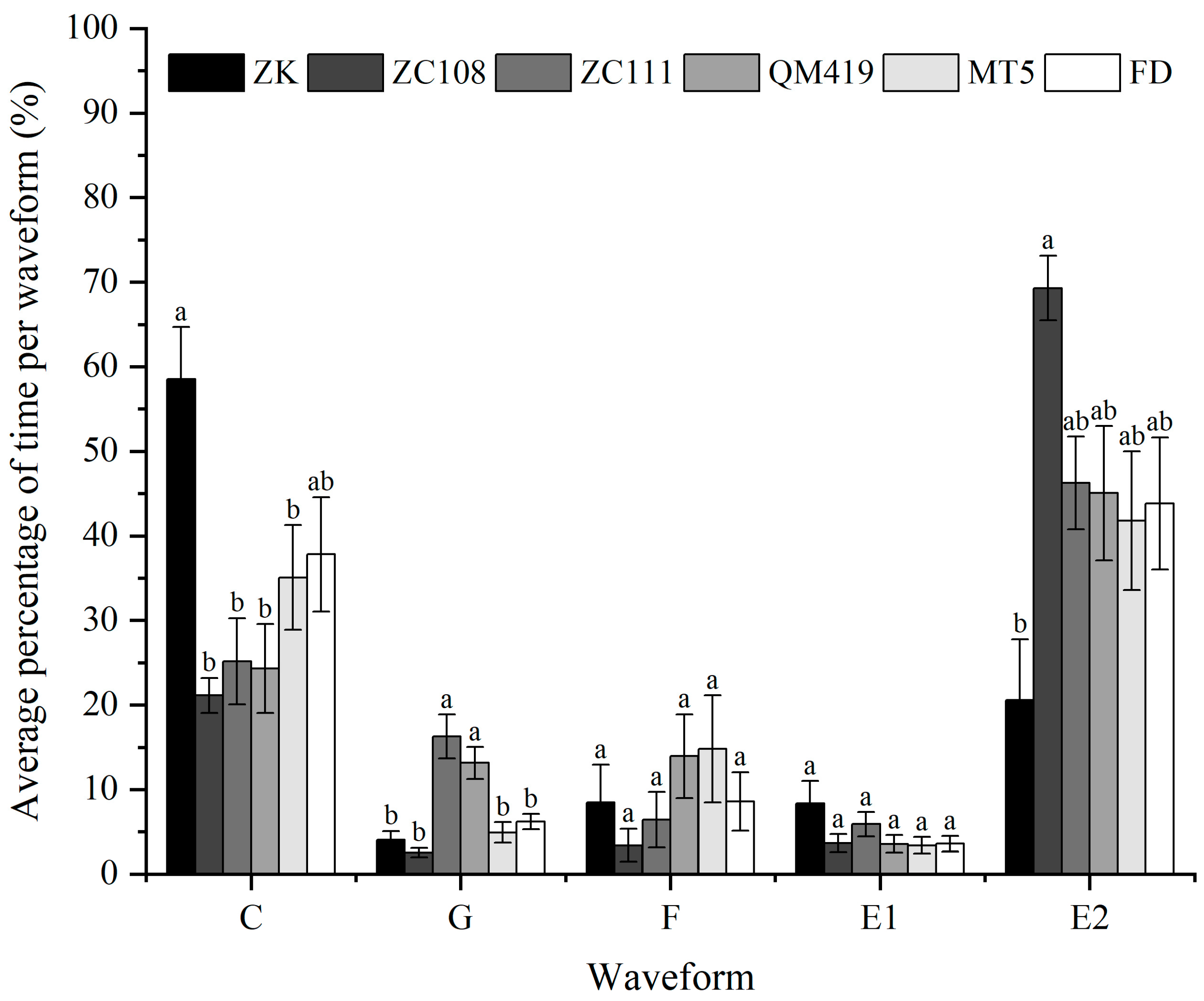
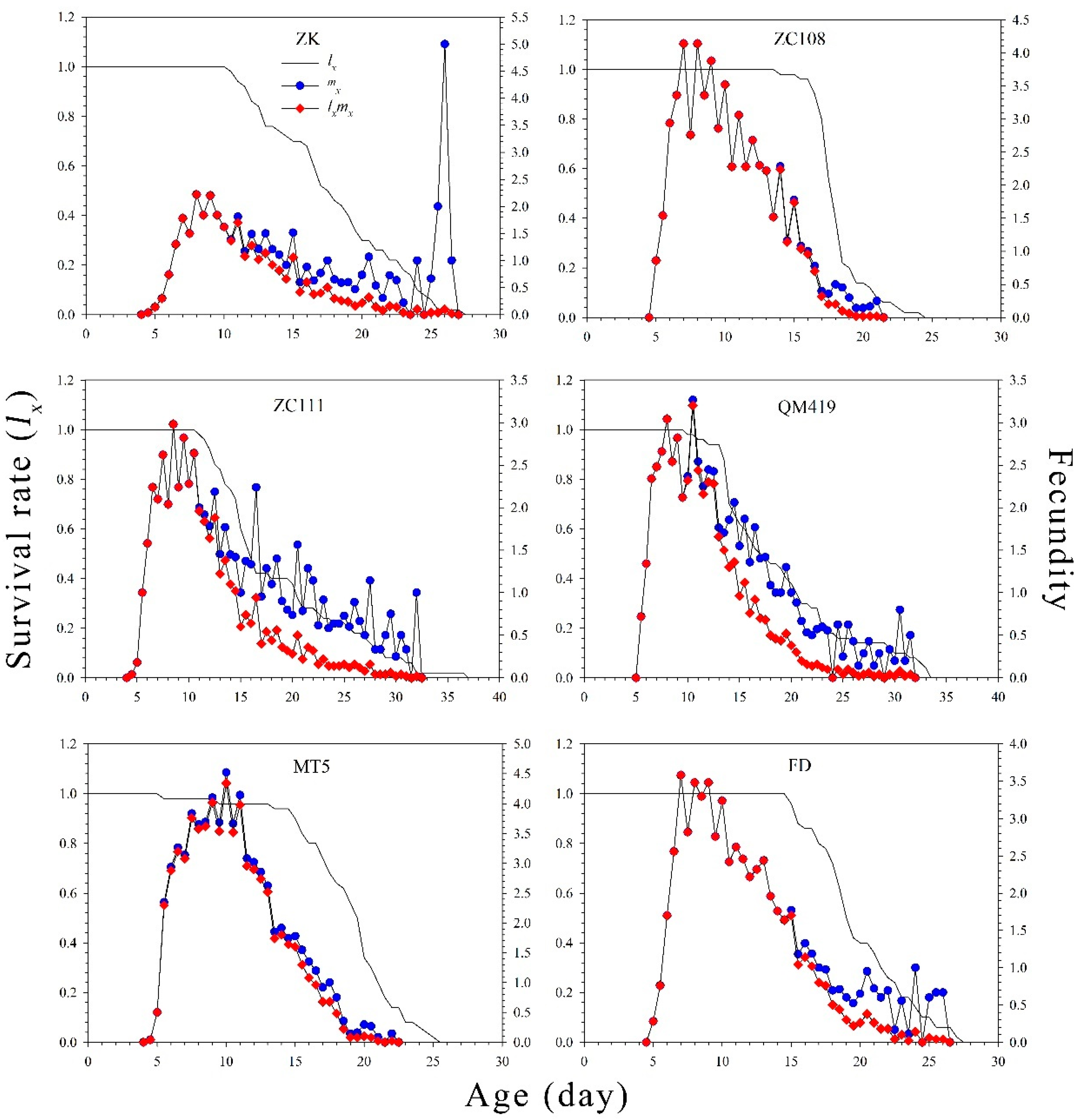
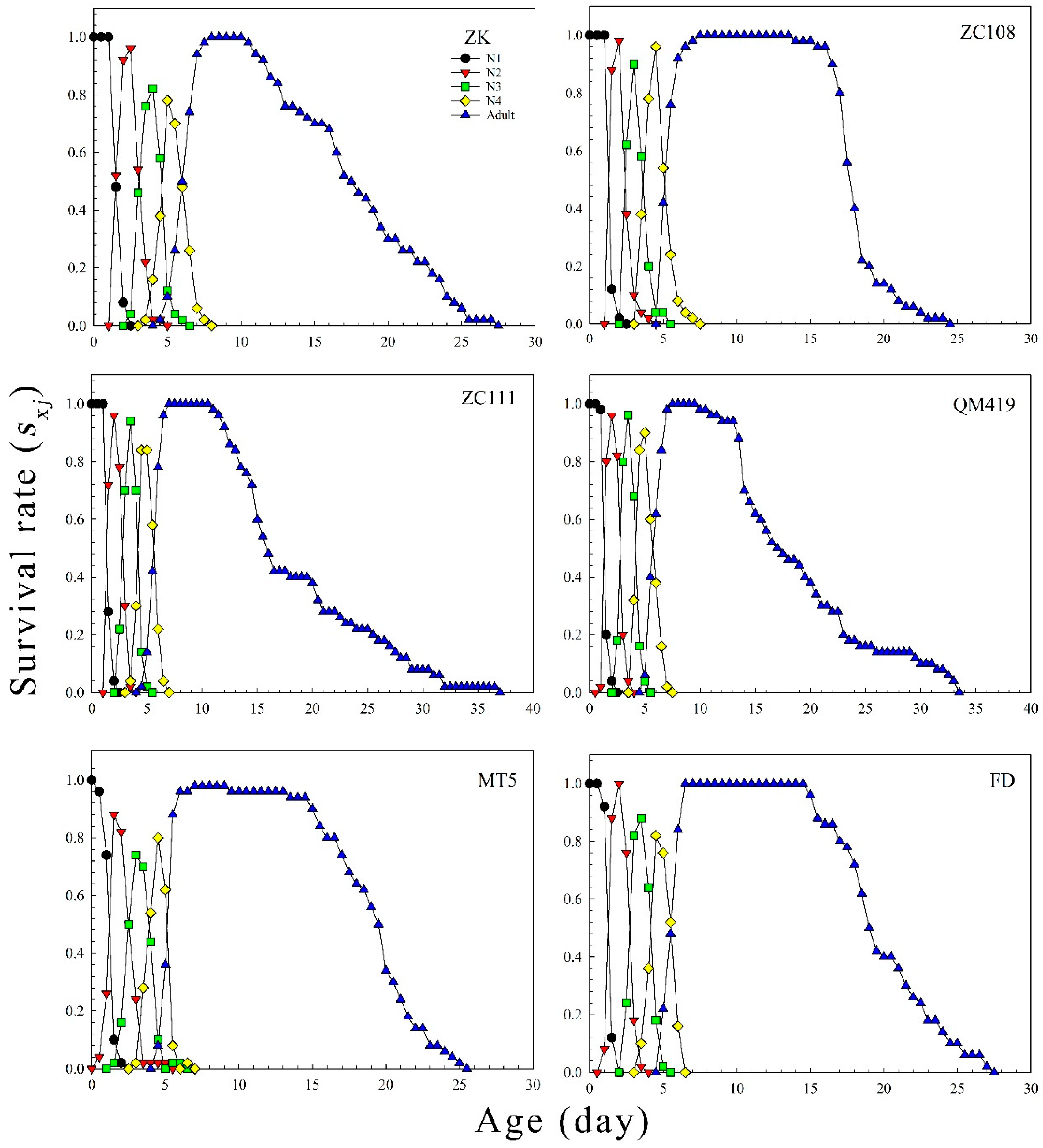
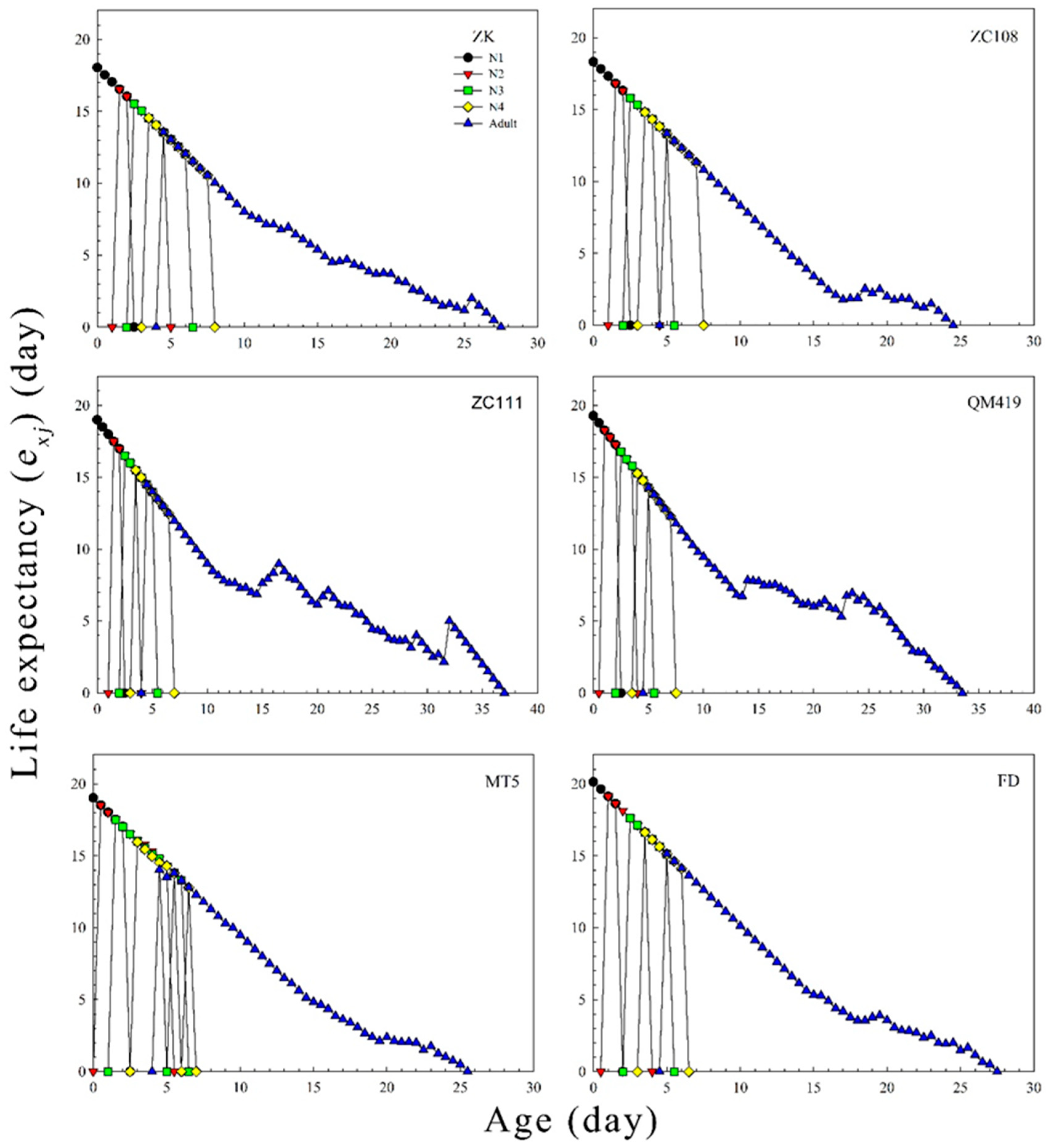
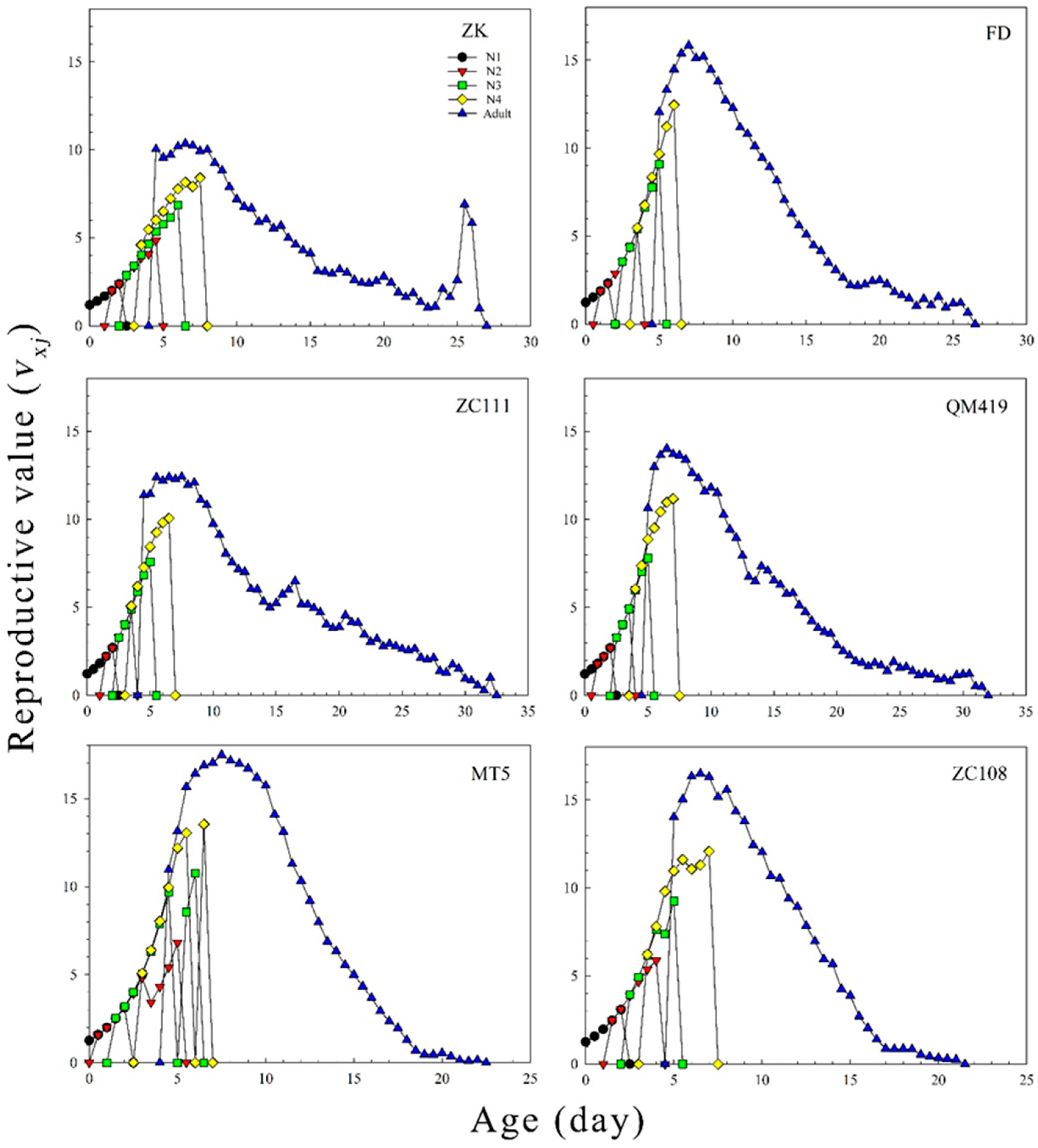
| No. | EPG Parameters | Tea Germplasms | p | |||||
|---|---|---|---|---|---|---|---|---|
| ZK | ZC108 | ZC111 | QM419 | MT5 | FD | |||
| 1 | Count probes | 14.60 ± 3.71 | 6.60 ± 1.77 | 14.60 ± 2.59 | 11.20 ± 2.39 | 11.67 ± 2.72 | 6.93 ± 3.18 | 0.171 |
| 2 | Sum time of np wave (min) | 20.33 ± 8.23 ab | 2.76 ± 0.60 b | 8.46 ± 2.22 ab | 6.88 ± 1.89 ab | 31.77 ± 13.34 a | 7.13 ± 5.68 ab | 0.035 |
| 3 | Duration of 1st probe (min) | 69.88±26.64 ab | 38.88 ± 23.54 b | 98.70 ± 37.59 ab | 79.67 ± 30.97 ab | 88.71 ± 38.62 ab | 204.50 ± 44.75 a | 0.026 |
| 4 | Number of probes to the 1st E1 | 6.13 ± 1.81 | 5.40 ± 1.62 | 10.07 ± 1.99 | 5.33 ± 1.55 | 9.60 ± 2.82 | 6.87 ± 3.19 | 0.508 |
| 5 | Count of Pd | 122.40 ± 16.22 | 77.60 ± 7.51 | 112.47 ± 10.18 | 102.20 ± 14.15 | 92.00 ± 9.20 | 92.40 ± 12.26 | 0.122 |
| 6 | Mean duration of pd (s) | 4.25 ± 0.31 ab | 4.05 ± 0.13 ab | 4.02 ± 0.11 ab | 3.82 ± 0.84 b | 4.95 ± 0.47 a | 4.07 ± 0.98 ab | 0.033 |
| 7 | Number of short probes | 8.00 ± 2.71 | 3.73 ± 1.34 | 8.67 ± 1.94 | 6.00 ± 1.55 | 6.27 ± 2.08 | 4.53 ± 2.50 | 0.521 |
| 8 | Total duration of C (min) | 218.57 ± 25.59 a | 77.78 ± 8.15 c | 89.41 ± 17.48 c | 111.72 ± 27.05 bc | 110.54 ± 15.62 bc | 186.45 ± 35.34 ab | <0.01 |
| 9 | Total duration of G (min) | 13.87 ± 3.63 b | 9.09 ± 2.00 b | 57.09 ± 9.08 a | 46.21 ± 6.52 a | 17.32 ± 4.29 b | 21.78 ± 3.21 b | <0.01 |
| 10 | Number of F | 5.00 ± 0.97 a | 2.07 ± 0.54 b | 1.80 ± 0.73 b | 1.73 ± 0.50 b | 1.07 ± 0.56 b | 1.93 ± 0.61 b | <0.01 |
| 11 | Total duration of F (min) | 24.13 ± 11.24 | 12.15 ± 7.01 | 22.60 ± 11.58 | 48.57 ± 17.00 | 51.03 ± 22.00 | 30.28 ± 12.47 | 0.343 |
| 12 | Number of E1 | 2.73 ± 0.62 | 2.87 ± 0.54 | 3.27 ± 0.80 | 2.40 ± 0.58 | 3.20 ± 0.86 | 1.73 ± 0.33 | 0.564 |
| 13 | Total duration of E1 (min) | 28.76 ± 9.06 | 13.02 ± 3.84 | 20.77 ± 5.05 | 12.61 ± 3.62 | 11.63 ± 3.30 | 12.76 ± 3.32 | 0.125 |
| 14 | Number of E2 | 1.33 ± 0.47 | 2.27 ± 0.36 | 2.53 ± 0.65 | 2.00 ± 0.54 | 2.67 ± 0.80 | 1.13 ± 0.20 | 0.244 |
| 15 | Number of sustained E2 (>10 min) | 0.53 ± 0.17 | 1.47 ± 0.22 | 1.47 ± 0.26 | 1.13 ± 0.22 | 1.67 ± 0.63 | 0.80 ± 0.11 | 0.094 |
| 16 | Total duration of E2 (min) | 73.17 ± 25.72 b | 247.56 ± 13.71 a | 162.93 ± 19.45 ab | 159.91 ± 28.40 ab | 141.31 ± 29.25 b | 155.88 ± 28.33 ab | <0.01 |
| Parameters | Tea Germplasms | p | |||||
|---|---|---|---|---|---|---|---|
| ZK | ZC108 | ZC111 | QM419 | MT5 | FD | ||
| First Instar (d) | 1.78 ± 0.05 a | 1.57 ± 0.03 bc | 1.66 ± 0.04 ab | 1.61 ± 0.04 b | 1.41 ± 0.05 c | 1.52 ± 0.03 bc | <0.01 |
| Second Instar (d) | 1.60 ± 0.04 a | 1.20 ± 0.04 c | 1.39 ± 0.04 bc | 1.42 ± 0.03 ab | 1.41 ± 0.08 ab | 1.46 ± 0.04 ab | <0.01 |
| Third Instar (d) | 1.42 ± 0.05 a | 1.19 ± 0.03 b | 1.36 ± 0.04 a | 1.41 ± 0.03 a | 1.35 ± 0.05 ab | 1.39 ± 0.04 a | <0.01 |
| Fourth Instar (d) | 1.43 ± 0.06 ab | 1.52 ± 0.04 ab | 1.43 ± 0.06 ab | 1.61 ± 0.08 a | 1.17 ± 0.05 c | 1.36 ± 0.04 bc | <0.01 |
| Preadult Duration (d) | 6.23 ± 0.11 a | 5.48 ± 0.08 cd | 5.84 ± 0.08 b | 6.05 ± 0.08 ab | 5.35 ± 0.07 d | 5.73 ± 0.07 bc | <0.01 |
| Adult Longevity (d) | 11.77 ± 0.67 | 12.84 ± 0.27 | 13.15 ± 0.93 | 13.23 ± 0.89 | 13.66 ± 0.51 | 14.40 ± 0.47 | 0.13 |
| Total Longevity (d) | 18.00 ± 0.66 | 18.32 ± 0.26 | 18.99 ± 0.93 | 19.28 ± 0.90 | 19.01 ± 0.52 | 20.13 ± 0.47 | 0.28 |
| APOP (d) | 0.15 ± 0.01 a | 0.02 ± 0.01 c | 0.11 ± 0.01 b | 0.16 ± 0.01 a | 0.12 ± 0.01 b | 0.11 ± 0.01 b | <0.01 |
| TPOP (d) | 6.38 ± 0.12 a | 5.50 ± 0.08 e | 5.94 ± 0.08 c | 6.22 ± 0.10 b | 5.47 ± 0.07 e | 5.85 ± 0.07 d | <0.01 |
| Larviposition Period (d) | 8.34 ± 0.07 f | 10.66 ± 0.02 c | 10.14 ± 0.09 d | 9.82 ± 0.08 e | 11.05 ± 0.06 b | 11.47 ± 0.05 a | <0.01 |
| Fecundity | 31.22 ± 2.11 d | 58.48 ± 1.18 a | 45.90 ± 2.82 c | 49.16 ± 2.68 bc | 66.04 ± 2.20 a | 57.42 ± 1.89 ab | <0.01 |
| Parameters | Tea Germplasms | p | |||||
|---|---|---|---|---|---|---|---|
| ZK | ZC108 | ZC111 | QM419 | MT5 | FD | ||
| λ (d−1) | 1.4147 ± 0.0143 e | 1.5751 ± 0.0011 b | 1.4890 ± 0.0013 d | 1.4880 ± 0.0012 d | 1.5831 ± 0.0011 a | 1.5230 ± 0.0011 c | <0.01 |
| r (d−1) | 0.3469 ± 0.0010 e | 0.4543 ± 0.0007 b | 0.3981 ± 0.0009 d | 0.3974 ± 0.0008 d | 0.4594 ± 0.0007 a | 0.4207 ± 0.0007 c | <0.01 |
| R0 | 31.3552 ± 0.2849 e | 58.3408 ± 0.1659 b | 46.7204 ± 0.4117 d | 49.3016 ± 0.3898 c | 66.0652 ± 0.3344 a | 57.2232 ± 0.2227 b | <0.01 |
| T (days) | 9.9289 ± 0.0237 a | 8.9507 ± 0.0108 e | 9.6523 ± 0.0232 c | 9.8062 ± 0.0239 b | 9.1216 ± 0.0125 d | 9.6201 ± 0.0152 c | <0.01 |
Disclaimer/Publisher’s Note: The statements, opinions and data contained in all publications are solely those of the individual author(s) and contributor(s) and not of MDPI and/or the editor(s). MDPI and/or the editor(s) disclaim responsibility for any injury to people or property resulting from any ideas, methods, instructions or products referred to in the content. |
© 2023 by the authors. Licensee MDPI, Basel, Switzerland. This article is an open access article distributed under the terms and conditions of the Creative Commons Attribution (CC BY) license (https://creativecommons.org/licenses/by/4.0/).
Share and Cite
Lu, C.; Shen, N.; Jiang, W.; Xie, B.; Zhao, R.; Zhou, G.; Zhao, D.; He, Y.; Chen, W. Different Tea Germplasms Distinctly Influence the Adaptability of Toxoptera aurantii (Hemiptera: Aphididae). Insects 2023, 14, 695. https://doi.org/10.3390/insects14080695
Lu C, Shen N, Jiang W, Xie B, Zhao R, Zhou G, Zhao D, He Y, Chen W. Different Tea Germplasms Distinctly Influence the Adaptability of Toxoptera aurantii (Hemiptera: Aphididae). Insects. 2023; 14(8):695. https://doi.org/10.3390/insects14080695
Chicago/Turabian StyleLu, Changhao, Ni Shen, Wenbin Jiang, Bi Xie, Runa Zhao, Guolan Zhou, Degang Zhao, Yingqin He, and Wenlong Chen. 2023. "Different Tea Germplasms Distinctly Influence the Adaptability of Toxoptera aurantii (Hemiptera: Aphididae)" Insects 14, no. 8: 695. https://doi.org/10.3390/insects14080695
APA StyleLu, C., Shen, N., Jiang, W., Xie, B., Zhao, R., Zhou, G., Zhao, D., He, Y., & Chen, W. (2023). Different Tea Germplasms Distinctly Influence the Adaptability of Toxoptera aurantii (Hemiptera: Aphididae). Insects, 14(8), 695. https://doi.org/10.3390/insects14080695






